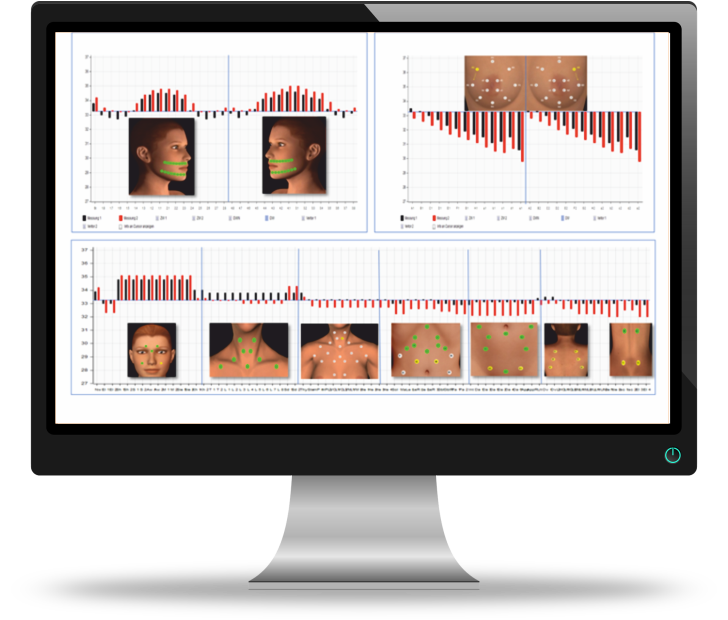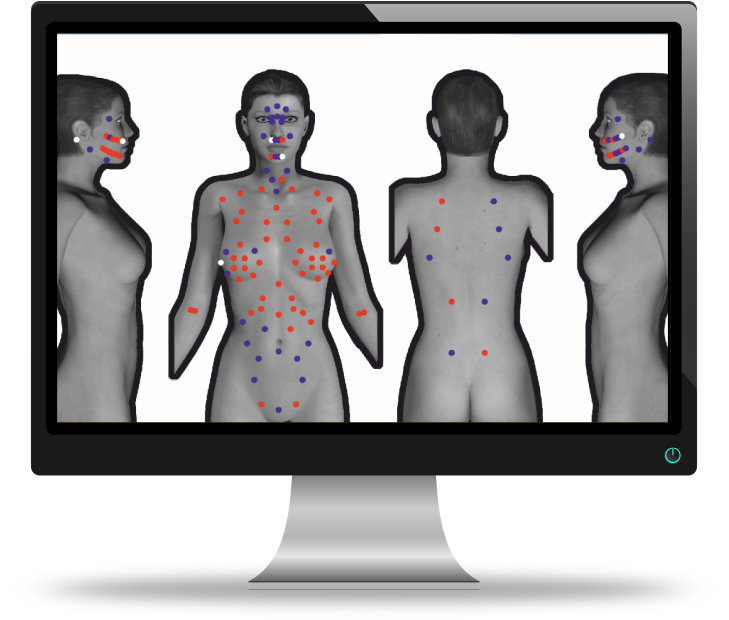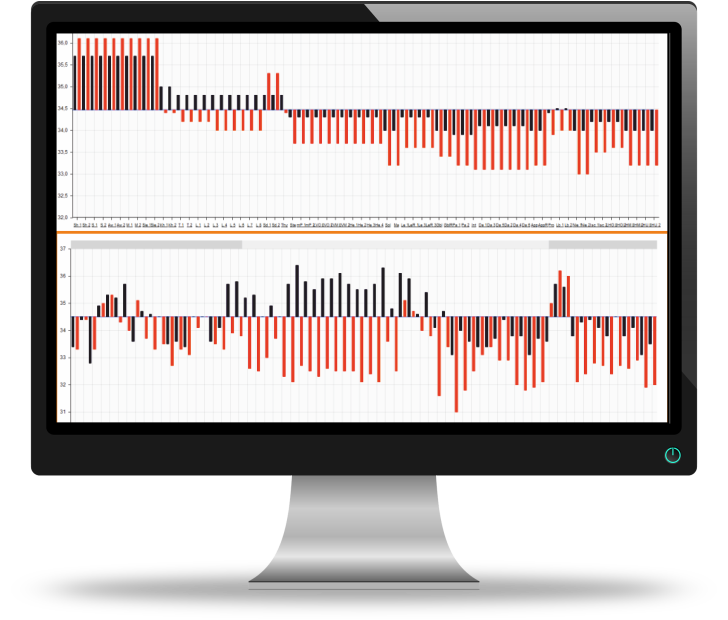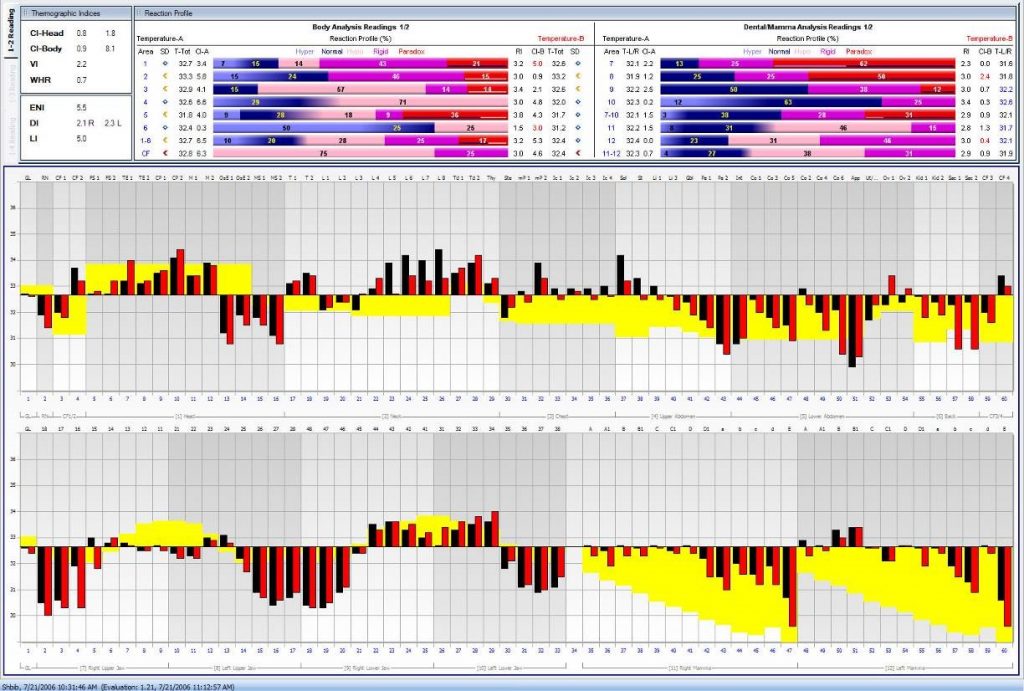Whole body status within one hour
Early detection of diseases before symptoms occur
What is computer regulation thermography?

Computer-Regulation-Thermography (CRT)
The heat exchange before and after a cold stimulus is measured at clearly defined areas of the body, including the face and chest. Blood circulation is largely responsible for the temperature on the surface of the body. It is controlled reflexively by the autonomic nervous system
(the part of the nervous system that we cannot influence with our will) and regulates the heat inside the body, which reaches the surface of the skin according to physiological laws and is measured and recorded there with a very sensitive sensor, down to a tenth of a degree.
Precisely defined points on the surface of the skin can therefore also be assigned to specific internal organs. Depending on the developing organ disorder, the skin temperature changes in a very characteristic way and thus becomes a “diagnostic instrument”.
A total of 120 defined skin areas are measured and then graphically displayed on a computer. This thermal image is as individual as each person’s fingerprint. The trained doctor can draw conclusions about all important organ systems from this thermal image and discuss them with the patient immediately after the measurement. If necessary, necessary therapeutic measures are also explained.



Why should such a CRT examination be carried out?
The early detection of diseases has always been the greatest challenge in medicine, as the manifestation of chronic diseases can either be delayed to a later age or, in the best case, avoided altogether.
Early detection means recognizing organ diseases when you are not yet experiencing any complaints or symptoms. Recognizing such a development enables the holistically trained doctor to interrupt or slow down this process by means of natural therapies or to lead it back to normality.
Another advantage is that the development of a disease that has already been diagnosed can be constantly monitored and the therapy can therefore be optimally adapted.
Certainly one of the most outstanding features of CRT is the ability to determine the causes of a disease when complaints are not revealed by laboratory tests or imaging procedures. These include in particular allergies, chronic pain, susceptibility to infections and rheumatism.
With the whole-body measurement it is therefore possible to create a risk profile and initiate the necessary therapeutic steps.
Our flyer on this topic
What does such a CRT examination reveal?
The CRT provides indications of an incipient circulatory disorder in the brain or heart, which can ultimately lead to a stroke or heart attack if this development goes unnoticed. These two organ diseases are still the most common causes of death, closely followed by cancer.
Furthermore, thyroid diseases, liver diseases, intestinal diseases, kidney diseases and metabolic diseases such as diabetes can be detected at an early stage, for example before abnormal laboratory values become apparent. The same applies to the prostate, breast, ovaries and uterus. In addition to these diseases, the function of the immune system and the lymphatic system is also recorded. Both organ systems are of enormous importance to ensure a strong body defense and detoxification.
Furthermore, by measuring the teeth, sources of disease and heavy metal contamination are detected, which are usually responsible for fatigue and reduced performance, but are often also triggers for rheumatism or allergies.
The causes of musculoskeletal complaints are usually identified by the CRT examination, enabling optimal treatment to be achieved.
All these findings are filtered out in a measurement that takes no longer than 30 minutes and provides you, the patient, with your personal risk profile.
CRT early detection of breast cancer without radiation exposure
Breast cancer, still the leading cancer in women, claims thousands of lives worldwide every year. Mammograms have not been able to reduce the number of breast cancer victims. On the contrary, they even pose a risk of cancer development, as X-rays can activate dormant tumor cells, so to speak. Mammography cannot really be called an early detection method, as it can only show existing tumors, which are on average about 1.3 cm in size. A tumor of this size already harbors more than a billion cancer cells and 25% of these tumors already have metastases at this stage.
However, CRT is already able to detect suspicious areas eight to ten years before this tumor stage, as it can visualize the local heat changes that precede any tumor formation. This leaves several years to support the organism with biological therapies so that, in the best case, the disease does not develop into a malignant form.
Early detection of breast cancer begins at the age of 20 and not at 40.
The examination is absolutely painless and without any exposure to harmful radiation. A total body measurement is always associated with early detection of breast cancer. In addition to the breast, all other organ systems and the immune and lymphatic systems can also be detected. Of course, the examination is also used once for women who already have breast cancer in order to detect any progression of the disease at an early stage and, of course, to optimize treatment.

CRT early detection of cancer risk in general
In general, CRT also indicates a general imminent risk of cancer, as the body undergoes very characteristic thermal changes regardless of the organ location, which the trained physician can recognize in the thermogram and then treat accordingly.
Procedure of the examination
The patient initially acclimatizes to the room temperature. The first measurement is taken at defined points on the body. The head, teeth and chest are also measured. The patient then undresses down to their underpants and remains sitting or standing in this room for 10 minutes at room temperature in a relaxed position, but without crossing their arms or legs (cooling stimulus). After the organism has cooled down, the second measurement is taken at the same points as the first measurement.
You must observe the following on the day of the examination
Do not shower and do not use any measures to promote circulation. Have a light breakfast, drink coffee or black tea if you are used to it, only take medication that you are used to. Your doctor can give you more information on this. Please wear a shirt, T-shirt or blouse, if possible not a turtleneck. Please wear long pants for the examination. Please do not use any creams, lotions or make-up.
Do you have any questions or would you like to make an appointment? Then please write to us or give us a call.
Our employees will answer your request quickly and competently. We will also be happy to call you back to give you individual advice. Or write to us. We are here for you.

